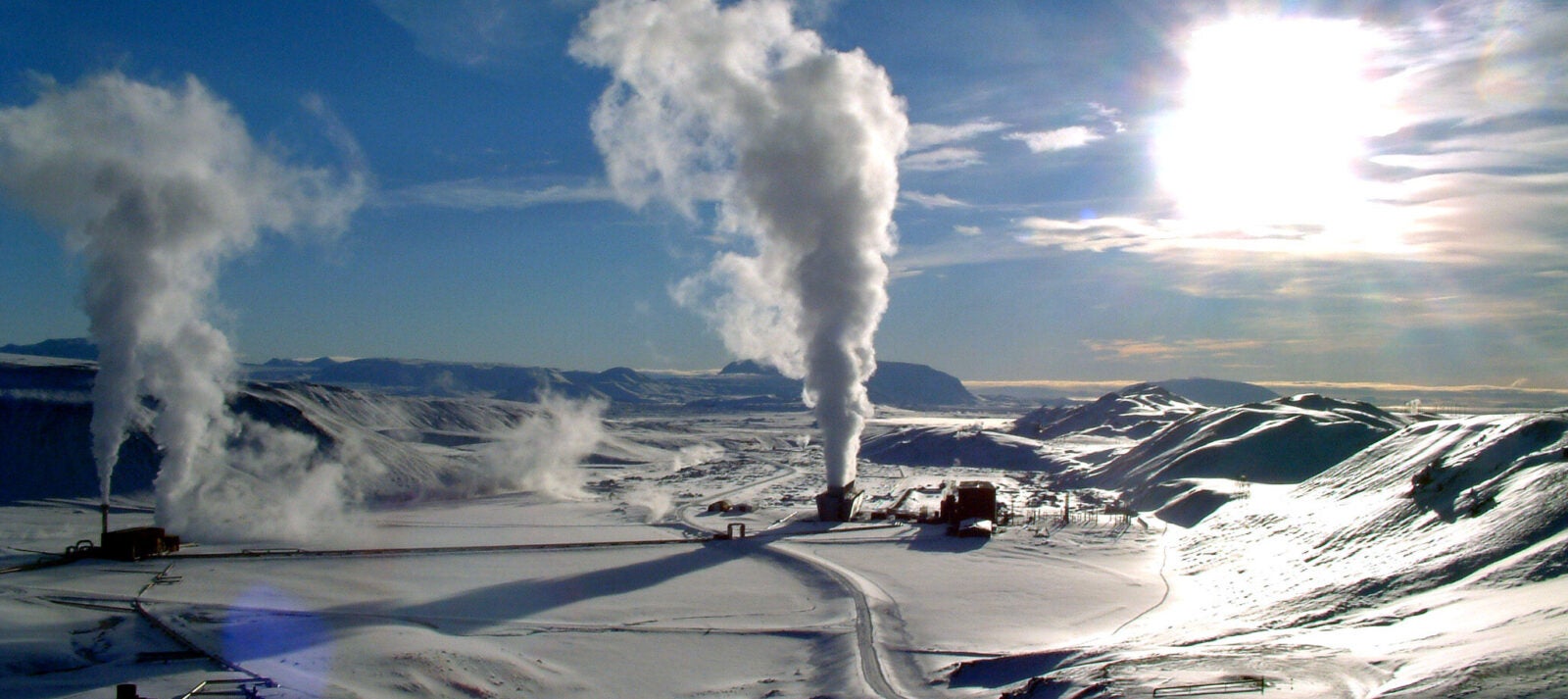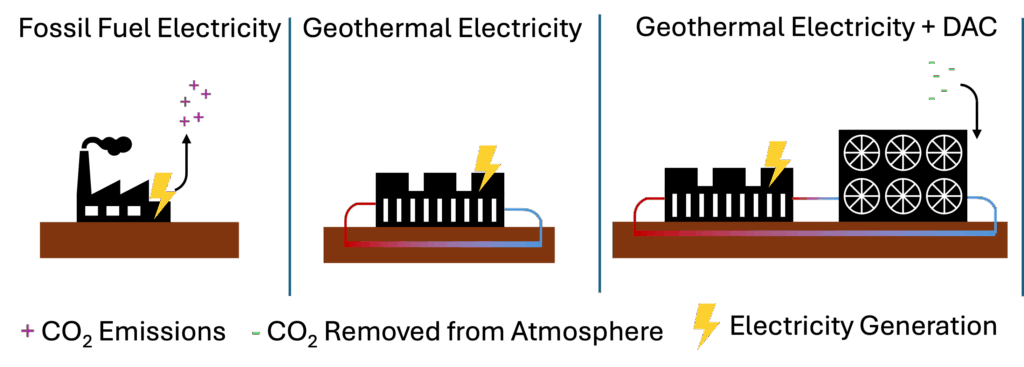
Renewable Energy is Not Just for the Grid: Supercharging Carbon Removal with Geothermal Energy Increases Carbon Abatement
Geothermal energy isn’t just for clean power—it can also drive carbon removal. New research from the Clean Energy Conversions Lab shows that pairing geothermal with direct air capture (DAC) can boost CO₂ abatement by up to 757%. Learn how this dual-use approach could reshape climate strategy and policy.
When we think about clean energy, we usually focus on renewable electricity generation–solar panels, wind turbines, and hydropower–and, more importantly, we focus on how these need to be deployed and scaled to sustain a carbon-free grid and a growing demand for electricity. However, mitigating climate change isn’t just about generating green electrons. It’s about balancing the tools we have to reduce ongoing carbon dioxide (CO2) emissions and to get rid of excess CO2 that is already in the atmosphere.
One way to reduce ongoing CO2 emissions is to switch to clean, renewable energy to displace fossil fuels from the grid. Renewable energy can also contribute to CO2 removal activities. Because the concentration of CO2 in the atmosphere is so dilute, separating CO2 from the mix of other molecules in the air can require a lot of energy. But, in the case of direct air capture (DAC), the majority of the energy needed to remove CO2 from the atmosphere is in the form of heat. Clean heat. This is where geothermal energy comes in.
Thanks to new federal incentives in the U.S., geothermal resources are being reimagined as a dependable, renewable power source that can support baseload power generation by providing a constant power supply to the grid 24/7. But the Clean Energy Conversions Lab’s research suggests we should also be thinking bigger. What if geothermal could do double duty—not just powering the grid, but actively removing CO2 from the air?
A Hidden Ally for Carbon Removal
Direct air capture (DAC) is a chemical-based technology that pulls CO2 directly out of the atmosphere. To work efficiently, most mature DAC systems require both electricity (20%) and low-to-moderate temperature heat (80%). To ensure that DAC has the greatest climate benefit possible, it must be powered by low-carbon heat and electricity. Geothermal energy, especially in the form of binary power plants, offers that renewable resource. Unlike solar or wind, geothermal can provide a steady supply of both heat and power, making it an ideal match for DAC. But does geothermal energy provide more climate benefits supporting DAC or generating low-carbon energy for the grid?
A Framework for Smarter Integration
To answer that, the Clean Energy Conversions Lab led a research study to investigate how heat and power can be shared between electricity production and carbon removal. Several designs were optimized for overall CO2 abatement (both CO2 reduction from geothermal electricity generation and CO2 removal from DAC) to see how various setups affect CO2 removal and cost.
What is a binary geothermal power plant?
A binary geothermal power plant works with two closed loop systems: one circulating the geothermal brine to extract the heat from the subsurface and the other circulating a working fluid to produce electricity. In the first loop, the geothermal brine is extracted from the underground geothermal reservoir, the heat from the brine is transferred to the working fluid of the other loop with a heat exchanger, and the brine is reinjected underground. In the second loop, the working fluid goes through and Organic Rankine Cycle to produce electricity. Reinjecting the brine maintains the pressure in the reservoir and avoid depleting the geothermal resource. It also ensures that no gases dissolved in the geothermal brine are released in the atmosphere, ensuring that binary geothermal power plants produce low-carbon electricity.

The results were striking. Integrating DAC systems with geothermal resources increased the overall CO2 abatement potential by 5% to 757% compared to using the same geothermal resource for electricity generation alone. This challenges the notion that renewable energy resources should solely be leveraged for low-carbon electricity production to have the greatest impact on climate change mitigation.

Cost, Constraints, and Opportunities
Of course, there’s no such thing as a free megaton. We also analyzed the levelized cost of energy delivered to DAC systems (LCOEDAC), which resulted in a vast range depending on the resource quality and system design. In some cases, especially with lower temperature resources or inefficient configurations, costs were too high to be viable today. However, in many cases, parameters could be altered to bring the LCOEDAC down to costs as low as $101/tCO2. Furthermore, in other configurations, particularly with well-matched geothermal-DAC setups, we found promising pathways for scalable, cost-effective deployment.
This opens up an important policy conversation. Today’s incentives for geothermal resource development tend to focus on electricity or small-scale heat integration (i.e., residential). But geothermal energy’s ability to supply clean, renewable heat to industrial applications is just as valuable, especially when paired with carbon removal.
Policy for a Dual-Use Future
As many jurisdictions double down on carbon management and clean energy, policymakers should consider how to:
- Support the co-location of geothermal and DAC technologies, including through demonstration projects.
- Design incentives that value both electricity and thermal energy use, especially when they contribute to carbon removal.
- Reward systems that maximize CO2 abatement, not just power generation.
Geothermal energy isn’t just a source of clean electrons—it’s a powerful and underused tool in our carbon removal toolbox. By pairing it with DAC, we can unlock new climate benefits and bring geothermal energy into the center of the net-zero conversation.
Maxwell Pisciotta
PhD, Chemical EngineeringMax Pisciotta is a Penn alum from the Clean Energy Conversions Lab. They hold a PhD in Chemical Engineering from Penn whose research focused on carbon capture and carbon removal. They served on the Kleinman Center Student Advisory Board and completed the 2021 Kleinman Birol Fellowship.
Hélène Pilorgé
Research Associate, Clean Energy Conversions LabHélène Pilorgé is a research associate with the University of Pennsylvania’s Clean Energy Conversions Laboratory. Her research focuses on carbon accounting of various carbon management solutions and on Geographic Information Systems (GIS) mapping for responsible deployment of carbon management.
Likhwa Ndlovu
Ph.D. Student, Chemical and Biomolecular EngineeringLikhwa Ndlovu is a Ph.D. student in the Department of Chemical and Biomolecular Engineering at the University of Pennsylvania. His research focuses on leveraging geoscience principles for the responsible deployment of carbon management solutions.
Jennifer Wilcox
Presidential Distinguished ProfessorJen Wilcox is Presidential Distinguished Professor of Chemical Engineering and Energy Policy. She previously served as Principal Deputy Assistant Secretary for the Office of Fossil Energy and Carbon Management at the Department of Energy.




